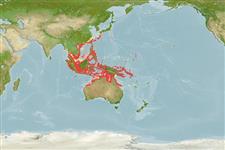>
Eupercaria/misc (Various families in series Eupercaria) >
Nemipteridae (Threadfin breams, Whiptail breams)
Etymology: Scolopsis: Greek, skolex = worm + Greek, opsis = appearance (Ref. 45335).
More on author: Peters.
Environment: milieu / climate zone / depth range / distribution range
Ökologie
seewasser riff-verbunden; tiefenbereich 3 - 60 m (Ref. 37816). Tropical; 32°N - 21°S, 96°E - 166°E (Ref. 3810)
Western Pacific: Andaman Sea in the eastern Indian Ocean to Indonesia, north to the Ryukyu Islands, south to northeastern Australia and the Solomon Islands. This species has been incorrectly referred to as Scolopsis personatus (a junior synonym of Scolopsis auratus) by some authors.
Size / Gewicht / Alter
Maturity: Lm ? range ? - ? cm
Max length : 24.0 cm TL Männchen/unbestimmt; (Ref. 9710); common length : 15.0 cm SL Männchen/unbestimmt; (Ref. 3810)
Rückenflossenstacheln (insgesamt): 10; Rückenflossenweichstrahlen (insgesamt): 9; Afterflossenstacheln 3; Afterflossenweichstrahlen: 7. Lower limb of preopercle scaly. Antrorse (forward-directed) suborbital spine absent. Pelvic fins long, reaching to or beyond level of anus. Larger specimens with upper and lower lobes falcate. Presence of indistinct bluish stripe between eyes and a narrow white stripe from middle of upper lip to below eye. Juveniles with dusky brown stripe on either side of dorsal midline, and dusky brown midlateral stripe, yellowish above anteriorly. Axillary scale present. Color: Body silvery-white. Top of head and snout dusky grey. An indistinct bluish stripe between eyes. A narrow white stripe from middle of upper lip to below eye.
Inhabits sheltered lagoons on sandy or muddy bottoms close to reefs. Occurs singly or in small aggregations. Adults mainly in depths over 15 m; juveniles solitary and in sheltered coastal habitats (Ref. 48635).
Life cycle and mating behavior
Geschlechtsreife | Fortpflanzung | Ablaichen | Eier | Fecundity | Larven
Russell, B.C., 1990. FAO Species Catalogue. Vol. 12. Nemipterid fishes of the world. (Threadfin breams, whiptail breams, monocle breams, dwarf monocle breams, and coral breams). Family Nemipteridae. An annotated and illustrated catalogue of nemipterid species known to date. FAO Fish. Synop. 125(12):149p. Rome: FAO. (Ref. 3810)
IUCN Rote Liste Status (Ref. 130435)
Bedrohung für Menschen
Harmless
Nutzung durch Menschen
Fischereien: kleinfischerei
Mehr Information
NamenSynonymeMetabolismusRäuberÖkotoxikologieFortpflanzungGeschlechtsreifeAblaichenSpawning aggregationFecundityEierEientwicklung
ReferenzenAquakulturAquakultur ProfilZuchtlinienGenetikElectrophoresesVererbbarkeitKrankheitenVerarbeitungNutrientsMass conversion
PartnerBilderStamps, Coins Misc.LauteCiguateraGeschwindigkeitSchwimmstilKiemenoberflächeOtolithsGehirngrößeSehfähigkeit
Tools
Zusatzinformationen
Download XML
Internet Quellen
Estimates based on models
Preferred temperature (Ref.
123201): 25.3 - 29.1, mean 28.3 °C (based on 1082 cells).
Phylogenetic diversity index (Ref.
82804): PD
50 = 0.5000 [Uniqueness, from 0.5 = low to 2.0 = high].
Bayesian length-weight: a=0.01622 (0.00730 - 0.03605), b=2.98 (2.80 - 3.16), in cm total length, based on LWR estimates for this Genus-body shape (Ref.
93245).
Trophic level (Ref.
69278): 3.3 ±0.39 se; based on food items.
Widerstandsfähigkeit (Ref.
120179): hoch, Verdopplung der Population dauert weniger als 15 Monate. (Preliminary K or Fecundity.).
Fishing Vulnerability (Ref.
59153): Low vulnerability (14 of 100).
Nutrients (Ref.
124155): Calcium = 64.7 [38.5, 128.3] mg/100g; Iron = 0.703 [0.347, 1.629] mg/100g; Protein = 18.9 [17.0, 20.6] %; Omega3 = 0.155 [0.093, 0.261] g/100g; Selenium = 31.2 [19.1, 55.5] μg/100g; VitaminA = 73.9 [21.0, 213.8] μg/100g; Zinc = 1.37 [0.95, 2.00] mg/100g (wet weight);
